10 Tips for Choosing the Right Light Fixtures for Each Room
When we moved into our current house, I was so focused on paint colors and furniture that I treated lighting like an afterthought. Big mistake. The living room felt flat after sundown, the bathroom mirrors cast spooky shadows, and the dining room’s oversized chandelier practically blinded us at dinner. It didn’t take long to realize that great light isn’t just about brightness—it’s about fit, function, and feeling in each room.
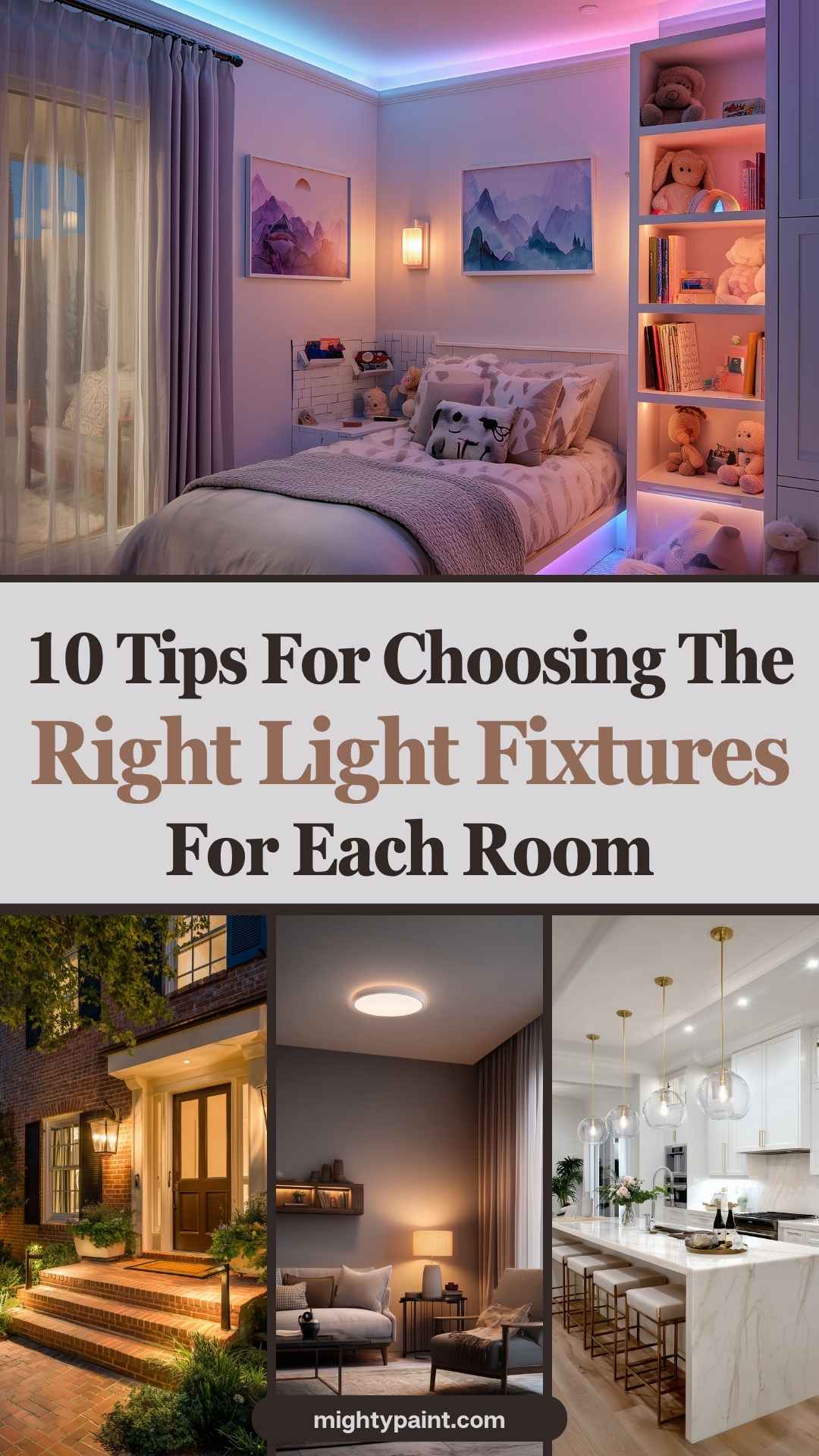
Picking the right fixture for a space means thinking beyond what looks pretty in a catalog. It’s about height, size, color temperature, placement, and how you want the room to behave. A cozy bedroom glow won’t cut it in a kitchen, and a hallway light too dim can feel like a tunnel. But once you understand the rules—and how to bend them—lighting becomes one of the most powerful design tools in your home.
In this guide, I’ll walk you through 10 room-by-room lighting tips that make every space feel purposeful, inviting, and functional. Each section ends with a simple rule of thumb you can use before you even leave the house for the hardware store. Whether you’re renovating, redecorating, or just replacing a bulb, these tips will help you light with confidence, not guesswork.
Lighting Fundamentals You Need First
Before we get into room-by-room strategies, it helps to understand the three lighting “layers” that should show up in almost every space—no matter its size or purpose. Lighting isn’t just about brightness—it’s about purpose, placement, and mood. Here’s your foundation.

Layers 101 – Ambient, Task, Accent
Think of lighting like music in a room. Ambient light is the bass line—it fills the space with general glow. Task lighting adds focus, like a clear vocal line in a song—it’s what you need to read, cook, or shave. Accent lighting adds the flair: under-cabinet strips, art spotlights, or decorative pendants that bring visual rhythm and personality.
In well-lit rooms, you’ll usually see a mix of all three.
- Ambient = overhead ceiling lights, recessed cans, flush-mounts
- Task = pendants over islands, vanity bars, desk lamps
- Accent = sconces, shelf LEDs, toe-kick strip lights
A good rule of thumb is 60% ambient, 30% task, and 10% accent—adjusted to your room’s size and function.
Know Your Numbers
Let’s decode a few terms you’ll see on lighting labels:
- Lumens = brightness (800 lumens ≈ 60-watt bulb)
- Kelvin (K) = color temperature.
- 2700 K: cozy & warm (bedroom, living room)
- 3000–3500 K: clean and bright (kitchen, bath)
- 4000 K+: crisp & cool (offices, garages)
- CRI (Color Rendering Index) = how true colors appear. Aim for 90+ CRI in bathrooms or makeup zones.
A high-lumen, cool-white bulb may look amazing in a laundry room but feel clinical over a dining table—so match the light’s temperature to the tone of the room.
Fixture Scale & Clearance Rules
No matter how stylish a fixture looks online, it has to fit in real life. Use these quick-sizing rules:
| Fixture Type | Rule of Thumb |
|---|---|
| Chandelier (room) | Room L (ft) + W (ft) = Diameter (in) |
| Pendant over Island | 1/3 island width or divide island length by # of pendants +1 |
| Hanging Height | 7 ft clearance min. for foot traffic zones |
These sizing tricks will come in handy across multiple rooms in this guide, especially when we cover dining, kitchen, and foyer lighting.
1. Entry/Foyer – First-Impression Glow
The foyer is your home’s welcome mat—so the lighting should both illuminate and impress. It’s often the first cue guests get about your home’s style and warmth.
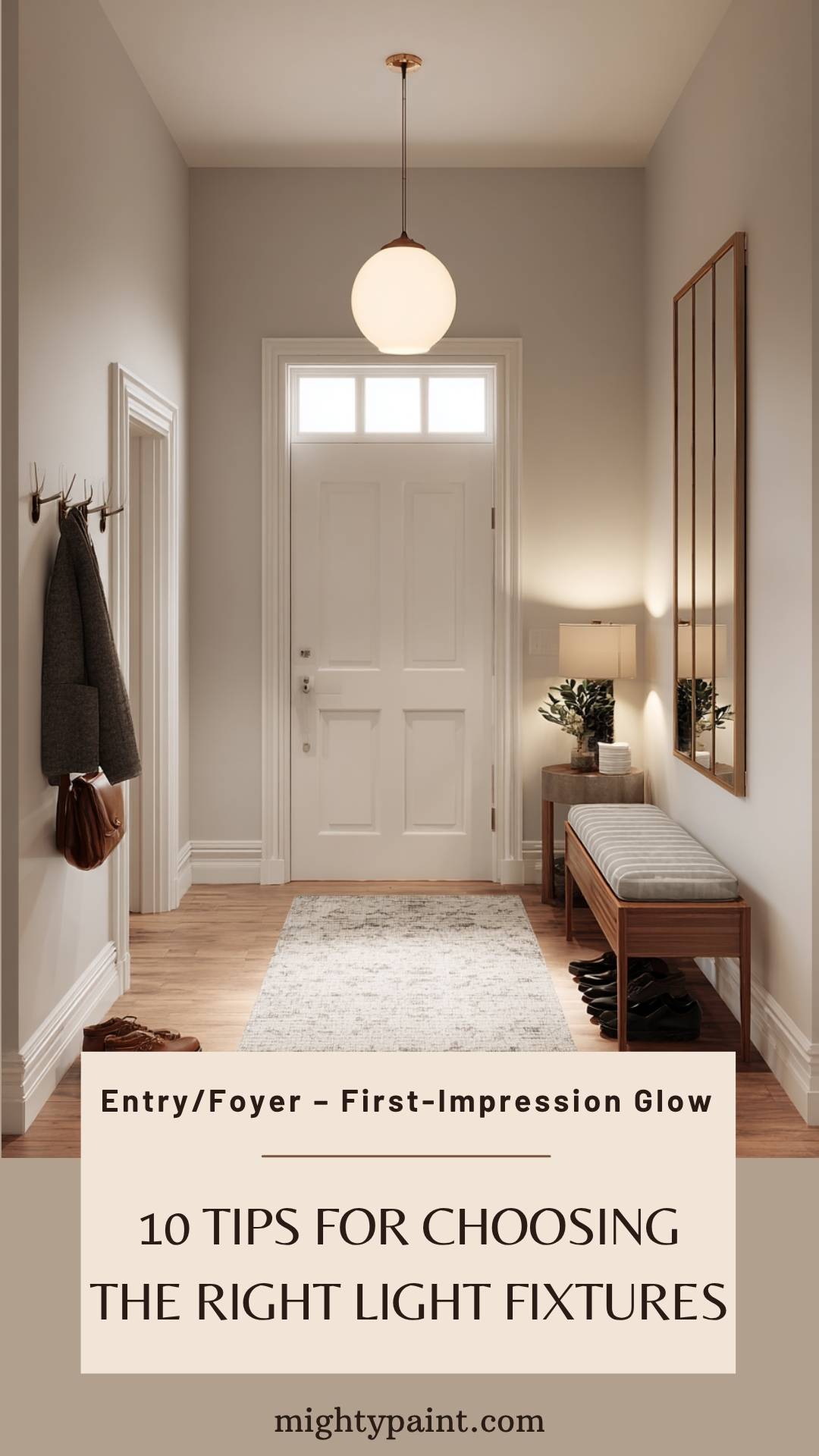
If the ceiling is standard height (8 ft), choose a flush or semi-flush mount to avoid crowding. Higher ceilings (9–12 ft or more) can handle a small chandelier or statement pendant. Just make sure the fixture hangs so its bottom sits at least 7 ft off the floor to avoid visual clutter or bumped heads.
Size Matters
A quick formula for picking the right diameter:
Room Width (ft) + Length (ft) = Ideal Fixture Diameter (in)
Example: A 6 ft × 8 ft entry → 14 in wide light looks right.
You don’t need a crystal showstopper here—think of a soft-glow pendant in aged brass, frosted globe, or textured linen to give a warm “hello” that flatters skin tones.
Pro Tip
Stick to 2700–3000 K bulbs. Too cool, and your entry feels like a waiting room. Too dim, and it’s a trip hazard when searching for shoes or keys.
2. Living Room – Layered & Dimmable
The living room wears many hats—TV zone, conversation corner, sometimes even a nap spot—so it needs layered light that adjusts easily. The goal here is to balance comfort and control.
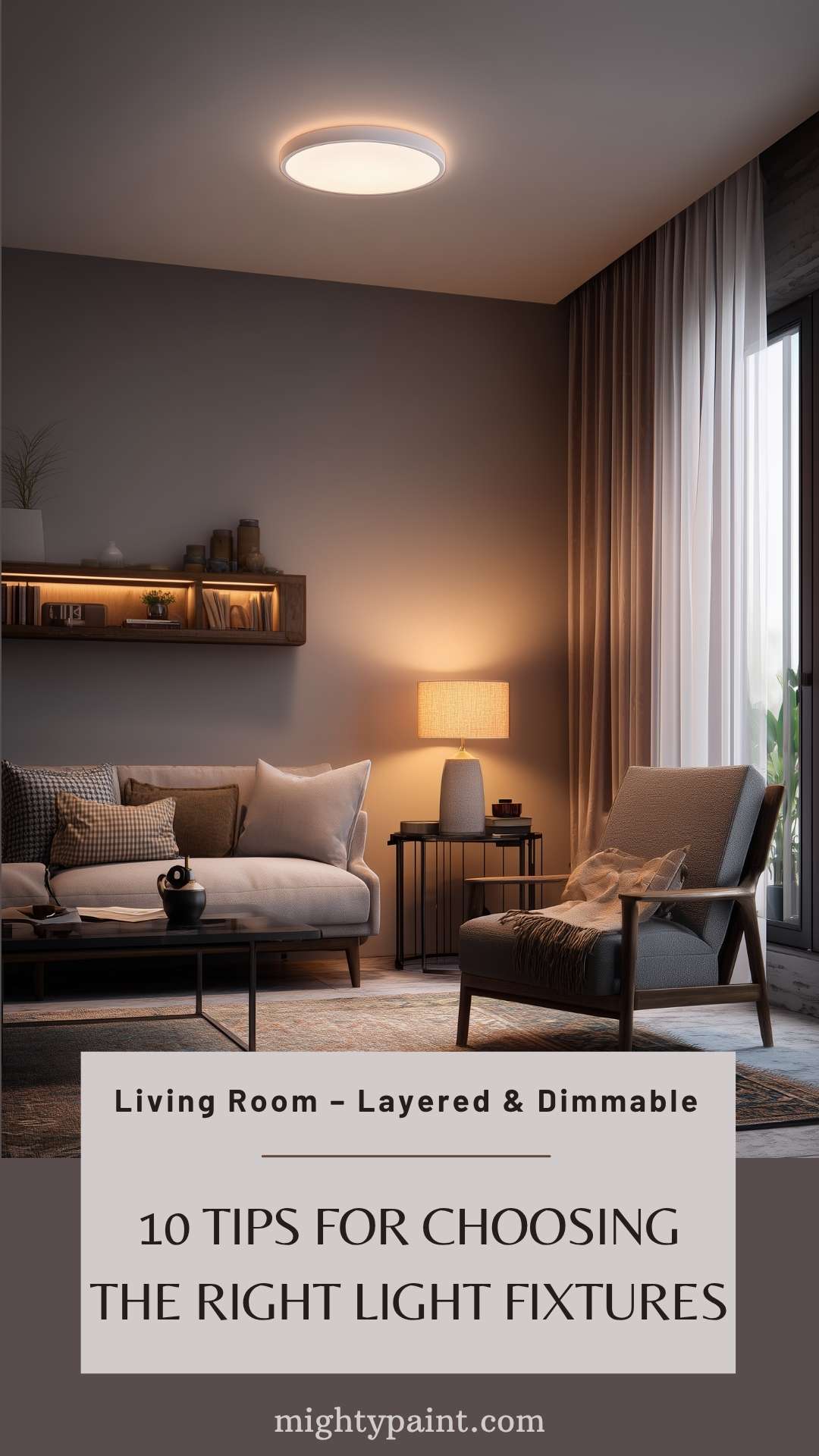
Ambient First
Start with an overhead fixture: a flush-mount, large drum pendant, or an evenly spaced grid of recessed cans. This layer fills the room without doing all the work.
Task & Accent Magic
Add table lamps beside seating and floor lamps in reading nooks. Position them so they shine across your shoulder, not directly into your eyes. Then add accent light: LED strips on shelves, uplights behind plants, or picture lights over art. This creates depth and avoids that flat, one-source glow.
Don’t Forget the Dimmer
Install dimmers on all overhead lights. This lets you drop the brightness for movie night or amp it up for cleaning marathons.
| Fixture Layer | Example |
|---|---|
| Ambient | Flush-mount, recessed grid |
| Task | Reading lamp, directional floor lamp |
| Accent | Shelf lights, wall sconces |
Use warm-white bulbs (2700–3000 K) to keep things cozy, and mix light heights to build mood.
3. Dining Room – Table-Centered Drama
The dining room is one of the few spaces where the light fixture is the focal point, even before the food hits the table. Whether your vibe is casual farmhouse or downtown cocktail hour, the right chandelier or pendant over the table adds both function and flair.
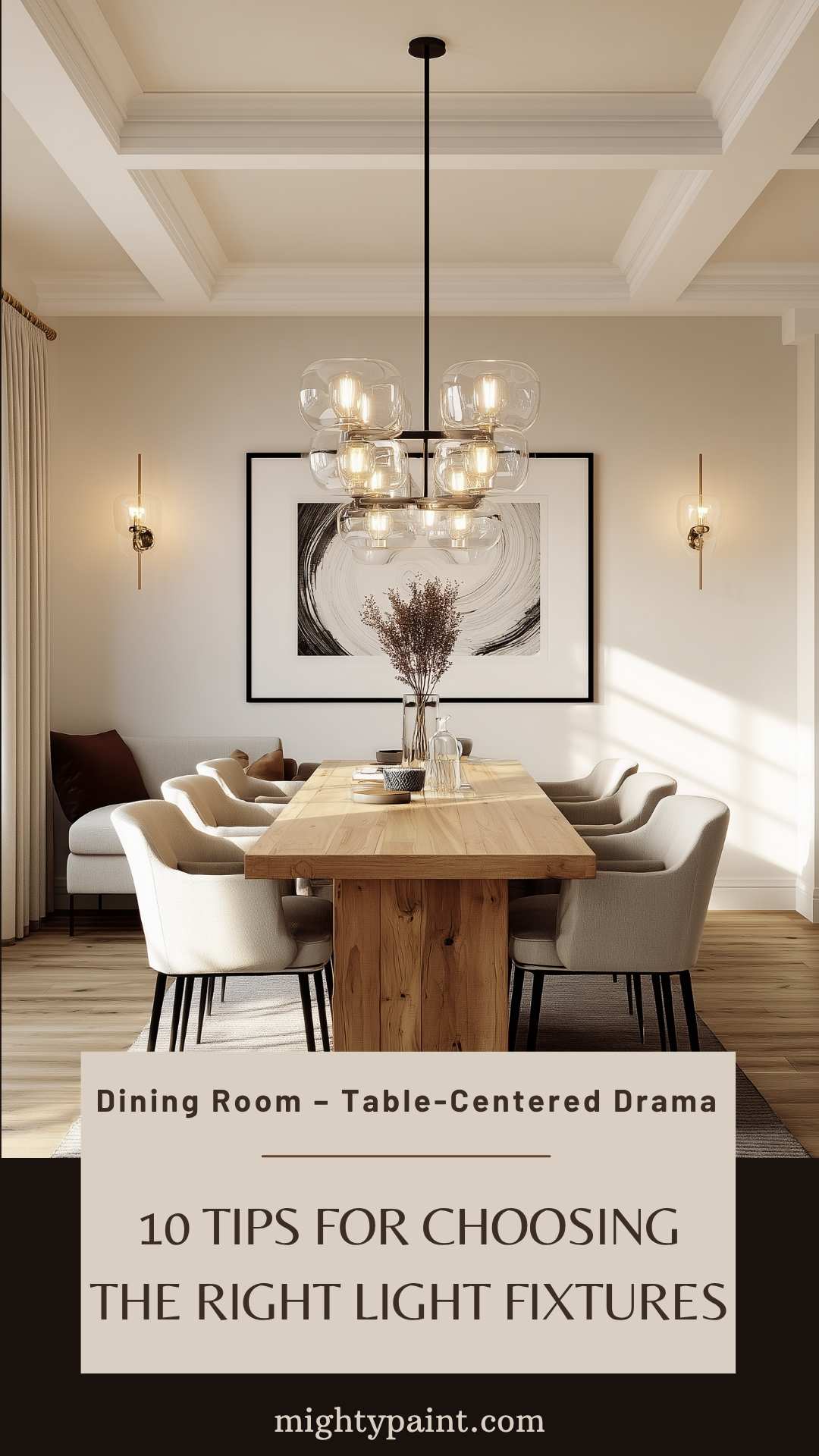
Get the Size Right
Too small, and the fixture gets swallowed up by the room. Too large, and it overwhelms the table. The trick? Let the room size guide the fixture size.
Formula:
Room Length (ft) + Width (ft) = Fixture Diameter (in)
So, a 12 ft × 10 ft room = 22 in-wide chandelier.
But if you’re sizing based on the table itself (common in open-concept homes), aim for a chandelier that’s ½ to ⅔ the width of the table.
| Table Width | Ideal Fixture Diameter |
|---|---|
| 36 in | 18–24 in |
| 42 in | 24–30 in |
| 48 in | 28–36 in |
Hang at the Right Height
The bottom of the fixture should sit 30–34 inches above the tabletop, especially on an 8-ft ceiling. Add 3 inches for every extra foot of ceiling height. This ensures guests see each other, not a glowing obstruction.
Warmth Is Everything
Use 2700 K bulbs for cozy, flattering glow—cool light feels sterile in a space meant for relaxed dinners. Dimmable bulbs are ideal so you can go from brunch-bright to candlelight-soft at night.
Fast Formula Recap:
- Fixture width = Room L + W (in feet)
- Hang 30–34 in above tabletop
- 2700 K bulbs for comfort
4. Kitchen – Task First, Style Second
In a kitchen, lighting has to work hard—no one wants to dice onions in the dark. But function and beauty can (and should) live together here. Focus on layered task and ambient light, with pops of style where they count.
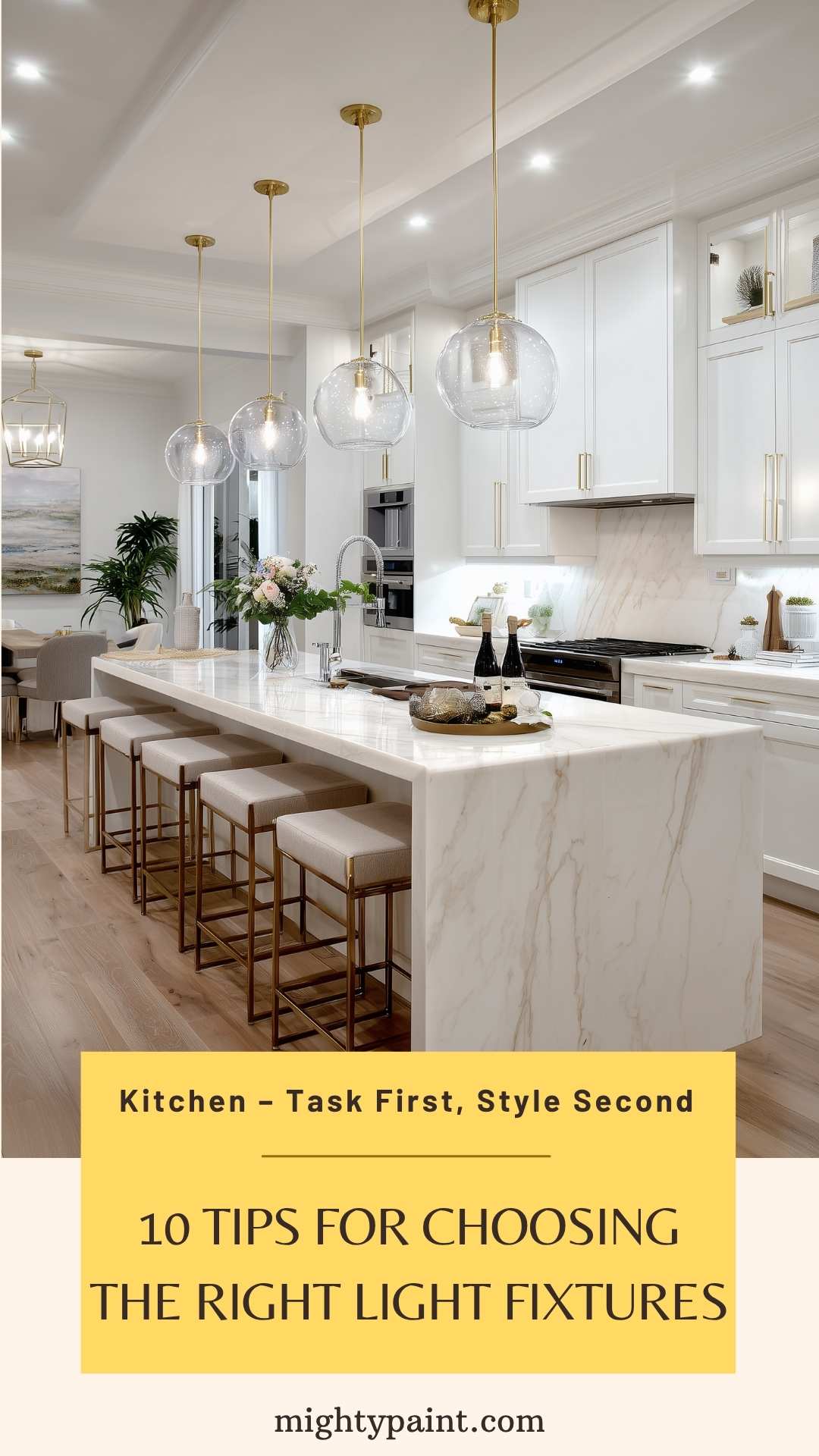
Pendant Power Over Islands
Pendants over a kitchen island not only light prep zones, they act like jewelry for your cabinets.
Height Rule:
Hang pendants 30–36 inches above the counter surface, and space them evenly to balance brightness and visual weight.
Spacing Formula:
Divide your island into sections by the number of pendants + 1.
Example: A 6-ft island with 2 pendants → divide into thirds = 24 inches apart.
| Island Length | # of Pendants | Spacing Guide |
|---|---|---|
| 4 ft | 2 small pendants | ~18–20 in apart |
| 6 ft | 2 medium pendants | ~24 in apart |
| 8 ft | 3 smaller pendants | ~24–30 in apart |
Don’t Forget the Under-Cabinet Glow
Install LED strip lighting under upper cabinets to eliminate counter shadows. These should be in the 3000–3500 K range for bright but not harsh color. Connect them to a separate switch so you can leave them on for a soft night-light effect after dinner.
Overhead + Accent Layers
Recessed lights on dimmers create flexible ambient lighting. Add small sconces or directional ceiling spots for open shelving or coffee nooks to highlight the details.
Fast Fix: Brightness first, mood second—make sure all work zones are lit before you choose the statement piece.
5. Bedroom – Soft Layers for Sleep
Bedrooms aren’t just for sleeping—they’re for reading, relaxing, even catching up on emails. That’s why lighting here should feel soft, personal, and easy to control from bed.
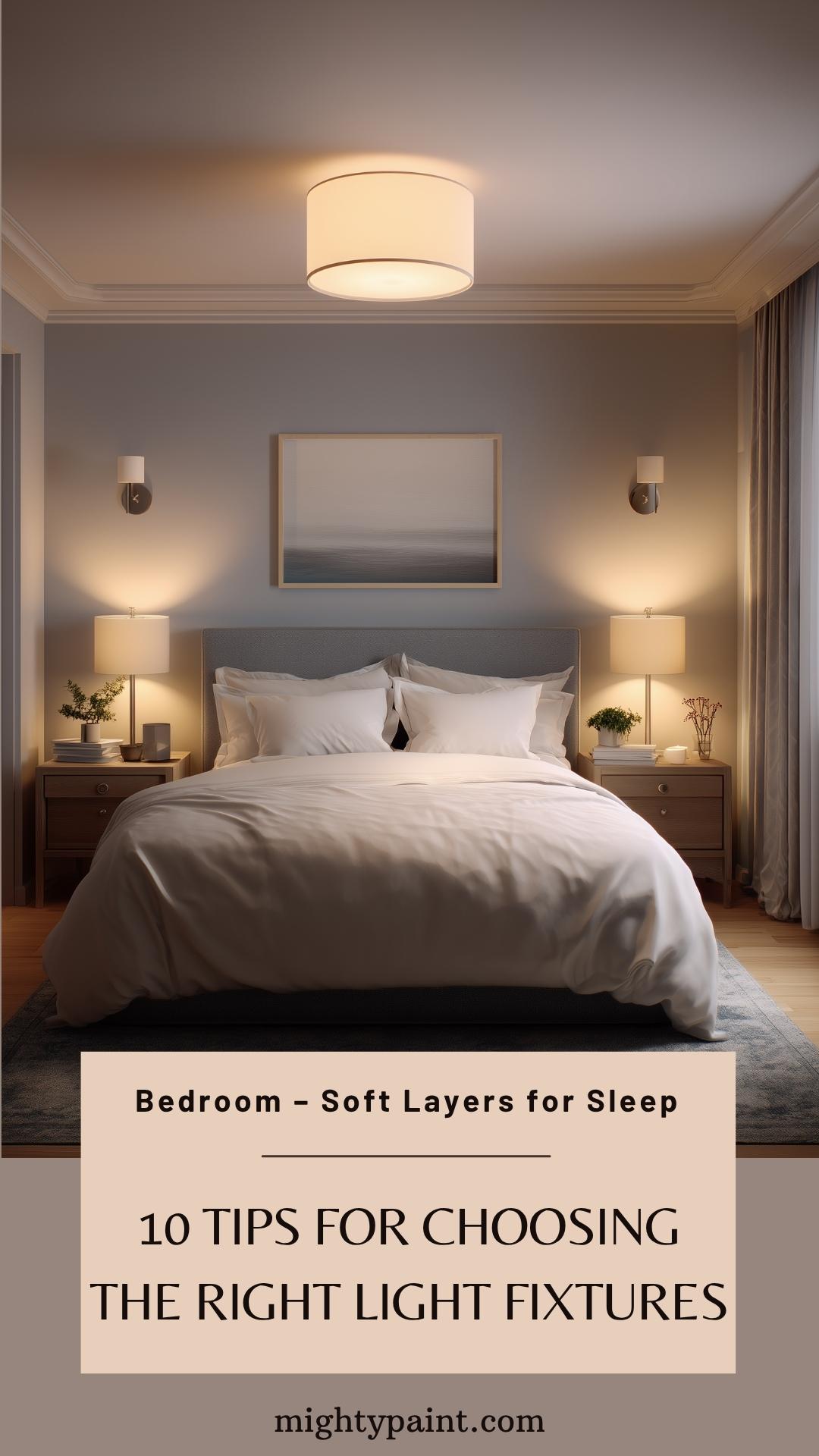
Skip the Glare
Instead of a bright overhead flush mount, go for a semi-flush fixture with a diffused drum shade or a small chandelier with dimmable bulbs. This softens shadows and creates a more relaxing atmosphere.
Layer with Task & Accent
Wall-mounted sconces or pendant lights beside the bed free up nightstand space and add that boutique hotel feel. They’re perfect for bedtime reading, especially if they have their own switches.
Mounting Tip:
Hang bedside sconces so the center of the bulb is 24–28 inches above the top of your mattress for perfect reading light without glare.
Choose the Right Bulb Temperature
Go warm—2700 K or even 2400 K—to support melatonin production and wind-down mode. If you like to scroll or read in bed, bulbs with low blue light output are even better.
Extra Tip: Add dimmers or smart bulbs so you can create presets: one for waking up, one for reading, and one for lights-out.
6. Bathroom – Face-Friendly Vanity Light
If there’s one room where lighting can make or break your day, it’s the bathroom. Harsh overheads and weird shadows can ruin even the best makeup or shave. The goal here is to create even, flattering light that mimics daylight—no unflattering downlights allowed.
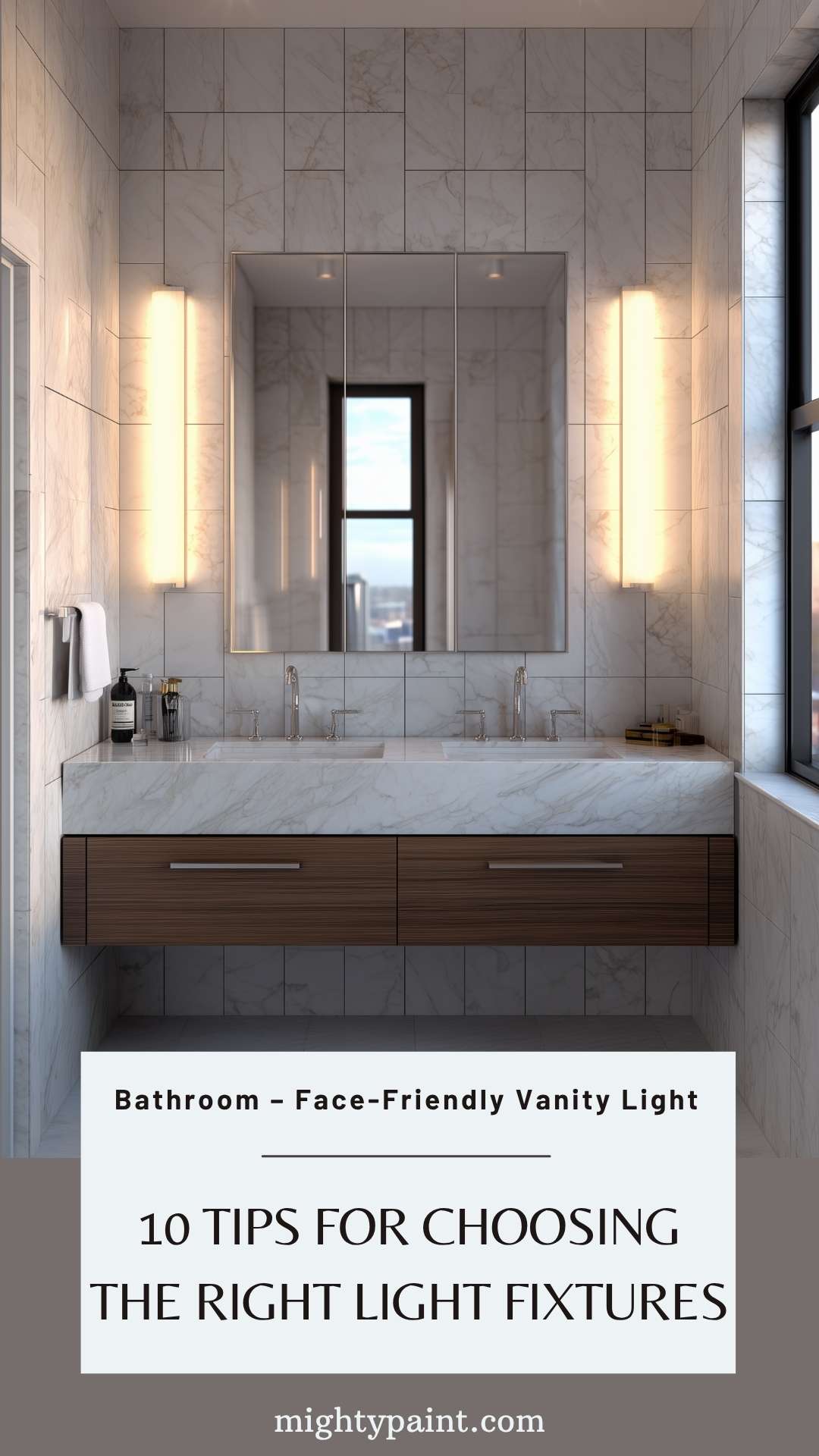
Skip the Overhead Glare
Ceiling lights alone cast shadows under your eyes and chin, which is why so many people feel like they “look tired” in the mirror. Instead, use a combination of vertical sconces on either side of the mirror, or a horizontal bar light above it if side mounts aren’t possible.
Mounting Guidelines:
- Sconces should be 60–66 inches off the floor and placed about 36–40 inches apart, depending on mirror width.
- Overhead bar lights should be mounted 75–80 inches off the floor and centered over the mirror.
Choose the Right Bulbs
You’ll want 3000 K for a clean, flattering tone that mimics natural daylight, and a Color Rendering Index (CRI) of 90+ to ensure skin tones look accurate. For makeup application, grooming, and skincare, this makes a world of difference.
Safety First
Always choose damp-rated fixtures for spaces with high humidity, especially if you’re mounting them above a tub or near a shower.
7. Home Office – Productivity Without Glare
A well-lit home office can make you feel sharper and stay focused longer—but only if the lighting is balanced, even, and glare-free. Relying on one overhead fixture often leads to eye strain and mid-day headaches. A layered approach keeps you productive and comfortable.
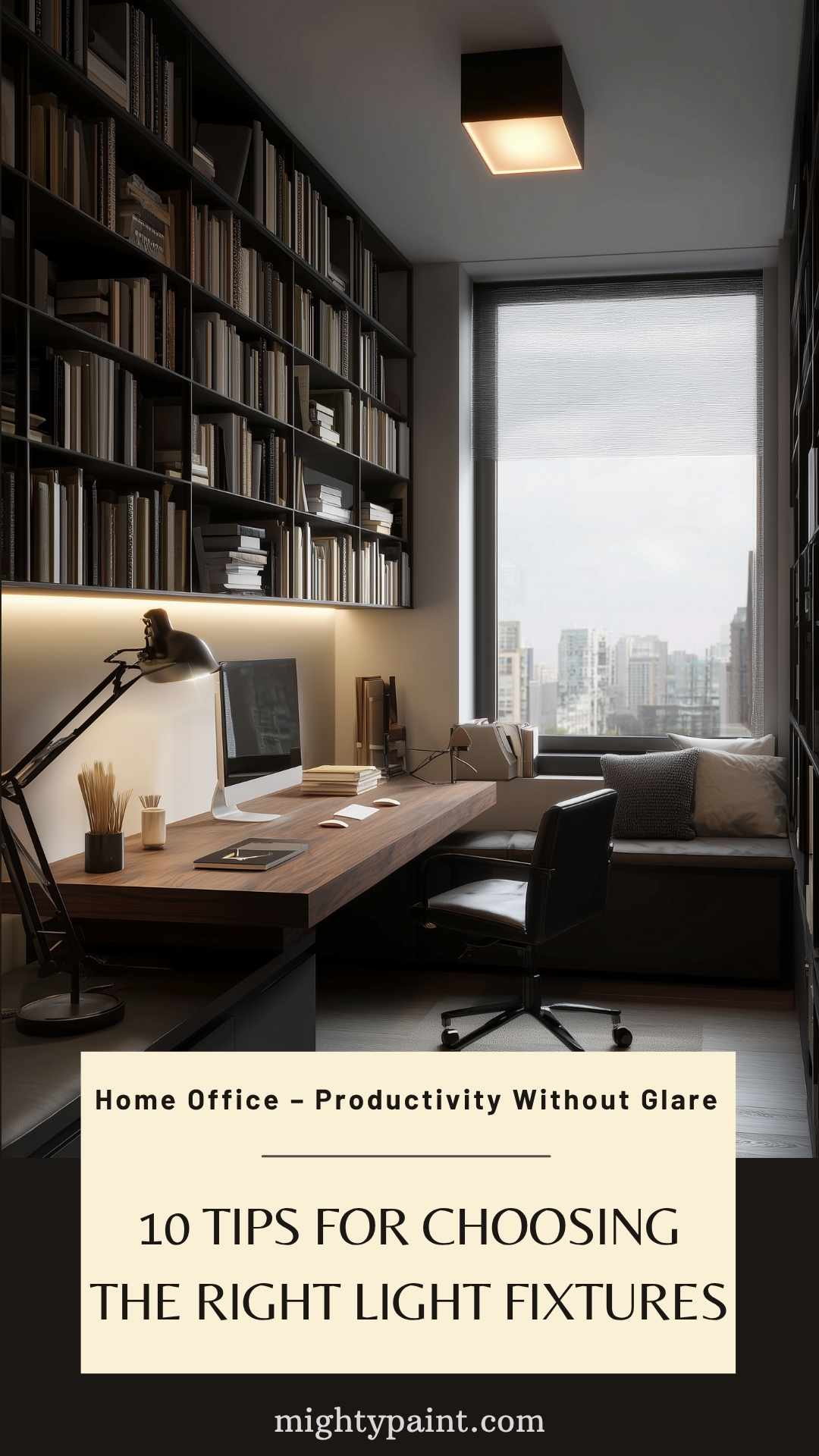
Start with Soft Ambient Light
Use a flush or semi-flush ceiling fixture with a frosted shade to avoid harsh shadows on screens. A wide beam spread (like from an LED panel or round flush-mount) prevents eye fatigue during long stretches at the desk.
Add a Targeted Task Lamp
Position a desk lamp opposite your writing hand to reduce shadows. Go for a fully adjustable arm and a wide shade to spread light evenly across your workspace. For maximum productivity, aim for bulbs in the 3500–4000 K range—cooler light that mimics daylight helps maintain focus.
Lighting Tip:
Look for task lamps that deliver at least 50 foot-candles (fc) at desk height for paperwork or drawing tasks.
Bonus: Go Smart
Tunable white bulbs or smart lamps let you shift color temperature throughout the day—from energizing bright white in the morning to warmer tones in the evening that help wind things down without disrupting your sleep cycle.
8. Kids’ Rooms – Safe & Changeable
Lighting in kids’ spaces needs to grow with them. That means safe, flexible fixtures that can shift from playful to peaceful, and won’t shatter if a stuffed animal goes airborne.
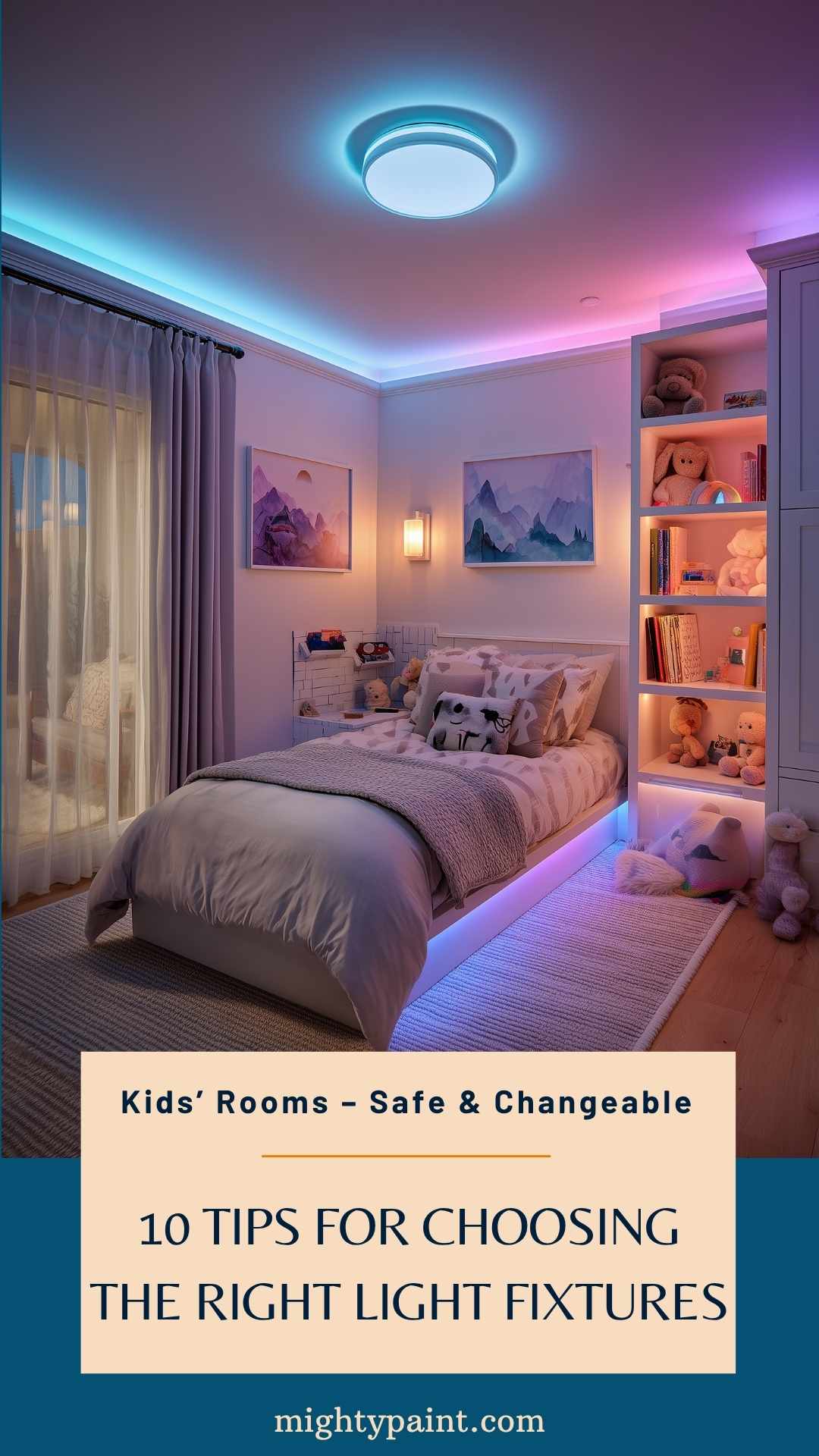
Keep it Low-Profile
Flush-mount or semi-flush ceiling lights are your best bet—no dangling pendants that could get knocked. Opt for impact-resistant materials and rounded edges.
Add Colorful Layers
RGB LED strip lights under beds or shelves turn the room into a playground. Set them to warm amber at bedtime, or blue and green for playtime. Kids love the control, and you get built-in mood cues throughout the day.
Nighttime Comfort
Plug-in nightlights or dimmable wall sconces help reduce bedtime anxiety without keeping the room too bright. Wall-mounted lights with separate switches are a win—your kid can control their glow without getting out of bed.
Safety Checklist:
- All fixtures should be damp-rated if a humidifier runs frequently.
- Make sure cords from table lamps or string lights are tucked and secured.
- Use LED bulbs that stay cool to the touch.
9. Hallways & Stairs – Guiding Lines
Hallways and staircases may not be where you hang out, but they’re high-traffic zones—and the wrong lighting here can be disorienting or even dangerous. The key is consistent, low-glare lighting that helps people move confidently without flooding the area in brightness.
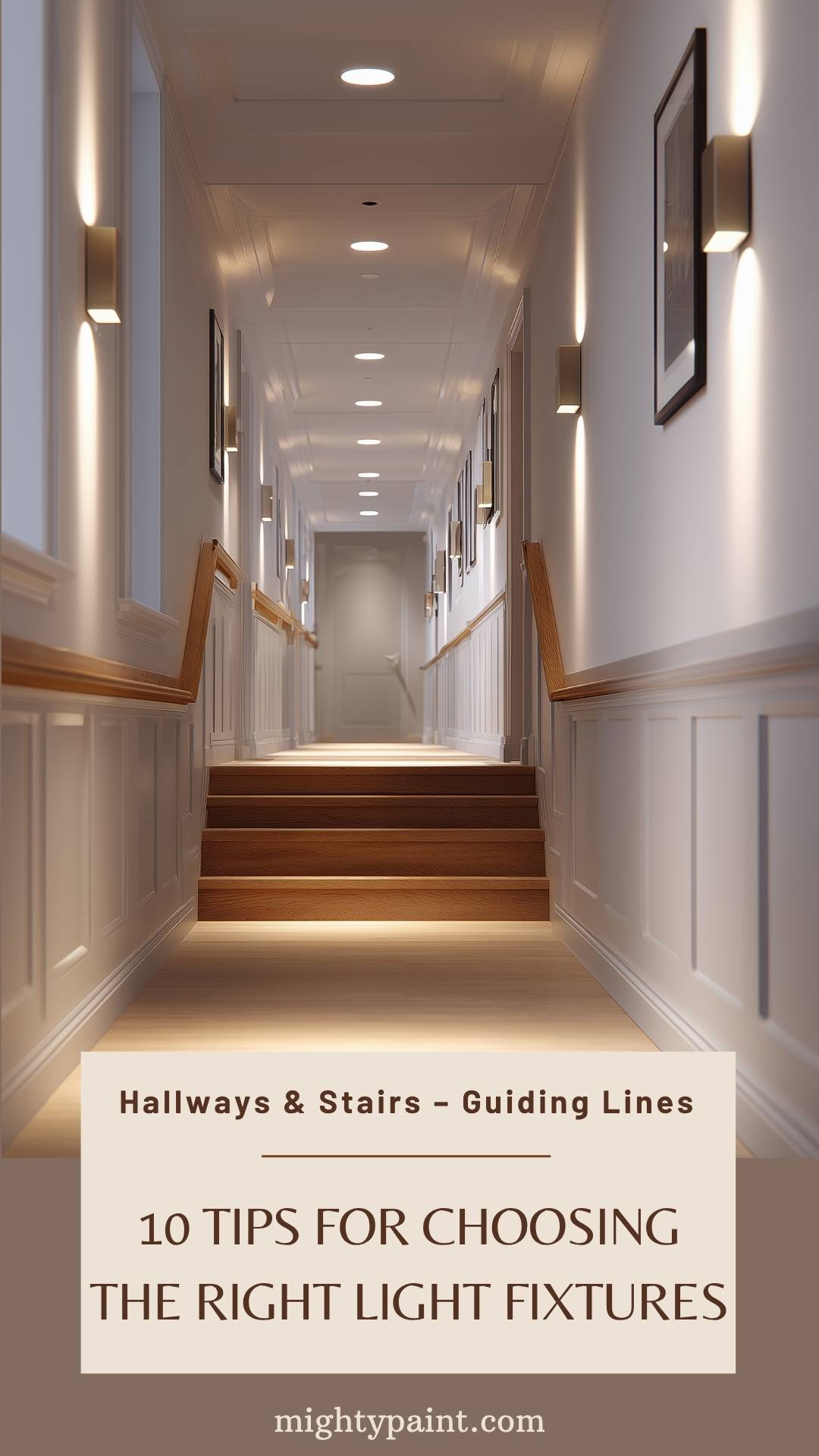
Space It Right
Flush-mount ceiling lights or compact recessed fixtures work best here. The rule of thumb is to place fixtures about every 8 feet, or at least one per segment if you’re dealing with landings or turns.
For staircases, use wall sconces or step lights placed low on the wall or along risers. These highlight depth and prevent stumbles.
Mind the Mood
You want enough illumination to see clearly at night, but not so much that it wakes everyone up on the way to the kitchen. Aim for 5–8 foot-candles (fc) and use dimmable bulbs where possible.
Energy Tip
Install motion sensors or timers in longer hallways or secondary stairwells. These save energy and offer convenience for those middle-of-the-night walks.
10. Outdoor Porch & Patio – Weather-Proof Layers
Outdoor lighting blends curb appeal with safety. Done right, it feels welcoming to guests and gives you peace of mind after dark. Just be sure to check for wet-rating or damp-rating labels—not all fixtures are built to handle the elements.
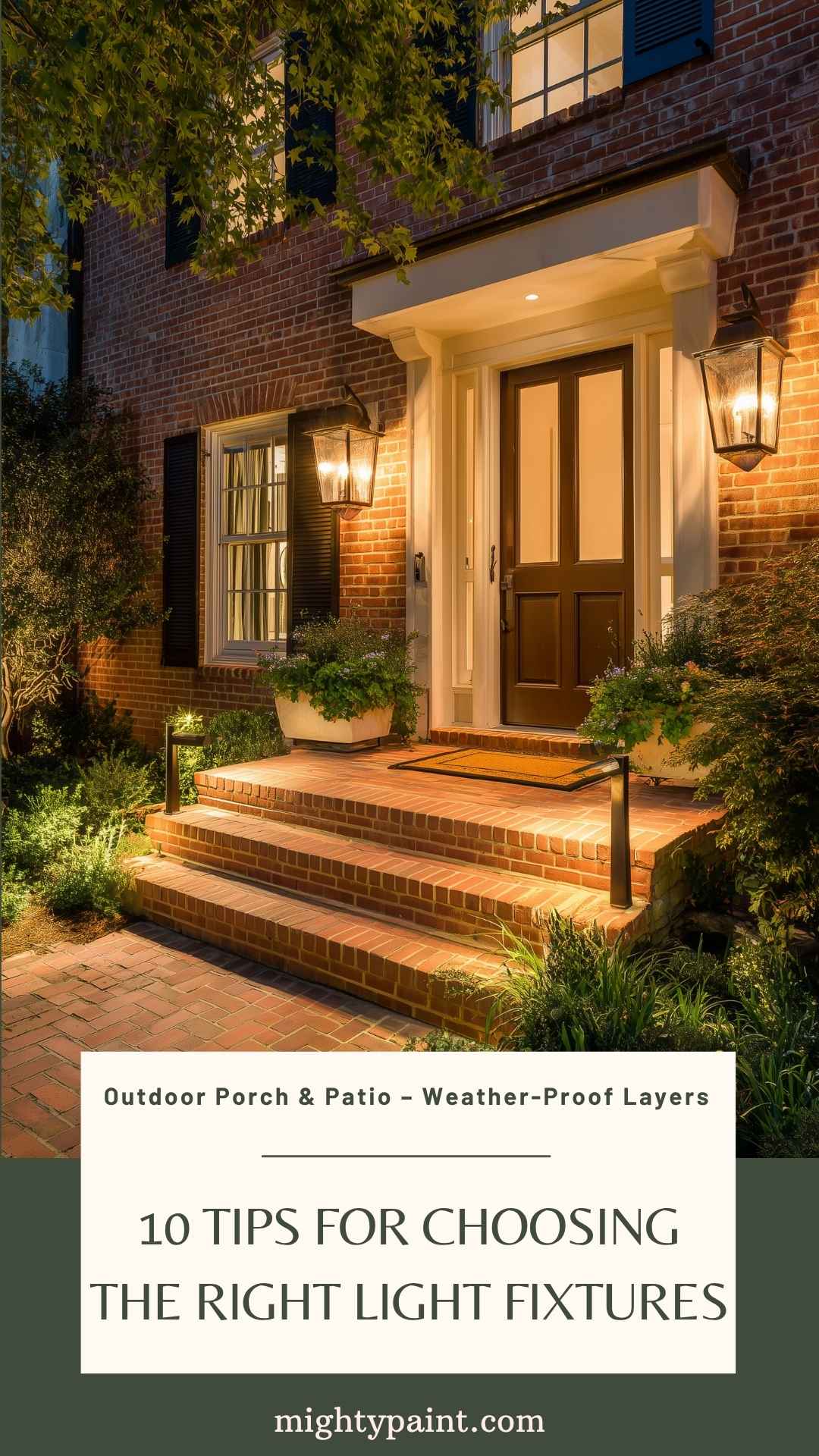
Front Porch Framing
Sconces or lanterns placed beside the door should measure about one-third the height of your front door. Mount them at eye level (around 66 inches from the porch floor) so they frame the entry without blinding your guests.
If your porch is covered and you want overhead light, use a wet-rated pendant or flush-mount. Stick to 2700 K bulbs to avoid that stark, bluish cast that attracts insects and washes out natural textures.
Patios & Walkways
Path lights spaced every 4–6 feet create rhythm and improve safety—especially around steps or garden edges. Use low-lumen, downward-facing LED stakes or bollards to avoid glare.
Layer in string lights, uplights on trees, or under-rail LED strips for evening ambience. Group everything on zones or timers so you don’t have to fumble with multiple switches at sunset.
Smart Controls, Dimmers & Energy Efficiency
Once the right fixtures are in place, you’ll want control. Smart dimmers, motion sensors, and tunable bulbs give you maximum flexibility with minimum effort.
Why Go Smart?
- Pre-programmed “scenes” (like Dinner, Movie, or Wake-Up) simplify daily routines.
- Voice control and app access let you adjust lighting without hunting for a switch.
- Vacation mode adds a security benefit by mimicking occupancy.
LED vs Incandescent – Worth the Switch
| Bulb Type | Lifespan | Energy Use | Cost over 10 yrs* |
|---|---|---|---|
| Incandescent | 1,000 hrs | 60 W | $150 |
| LED | 25,000 hrs | 9 W | $30 |
*Based on 3 hrs/day use and average U.S. energy rates.
Pair smart lighting with Title 24-compliant fixtures (in the U.S.) or your region’s building code recommendations for long-term savings and fewer replacement headaches.
Common Mistakes & How to Dodge Them
Even with the best intentions, it’s easy to misstep when choosing lighting—especially when there are hundreds of fixtures to scroll through and dozens of styles competing for attention. Here are the most common traps and how to avoid them.
1. Ceiling-Only Syndrome
Relying solely on overhead lights flattens a room and leaves corners dim. The fix? Layer your lighting—always include a mix of ambient, task, and accent fixtures. For example, in a living room, pair a central flush mount with floor lamps and wall sconces to soften the space.
2. Oversized or Undersized Fixtures
A chandelier that’s too large overwhelms a dining table; one that’s too small looks like an afterthought. Stick to the sizing formulas we’ve shared earlier to find the sweet spot. When in doubt, cut a cardboard circle in your desired diameter and hold it up—it’s a quick visual test that saves time.
3. Mismatched Color Temperatures
Mixing warm (2700 K) and cool (4000+ K) bulbs in the same room is a recipe for visual tension. Pick one color temperature per room or functional area to keep the space cohesive. Kitchen under-cabinet lighting at 3000 K, for instance, shouldn’t clash with 5000 K recessed overheads.
4. Ignoring Natural Light
Rooms that get heavy afternoon sun may not need as many high-lumen fixtures. Likewise, north-facing rooms might need help from brighter bulbs or reflective finishes. Always consider how sunlight moves through the space before finalizing your lighting plan.
Conclusion & Quick Decision Checklist
Lighting is more than decoration—it’s functional mood-setting. It helps you work better, sleep deeper, and feel more at ease in your own space. Whether you’re upgrading a single pendant or redoing an entire room, the best results come from a layered, thoughtful approach.
Here’s a quick checklist you can use for every room:
✅ What is the primary function of this space (relaxing, working, eating)?
✅ Have I included ambient, task, and accent layers?
✅ Is the fixture size and height appropriate for the space and ceiling?
✅ Have I chosen the right color temperature (Kelvin) for mood and function?
✅ Are all bulbs within the same color temperature range?
✅ Did I include dimmers, smart controls, or motion sensors if needed?
✅ Have I considered long-term efficiency (LEDs, wet/damp ratings, Title 24 compliance)?
